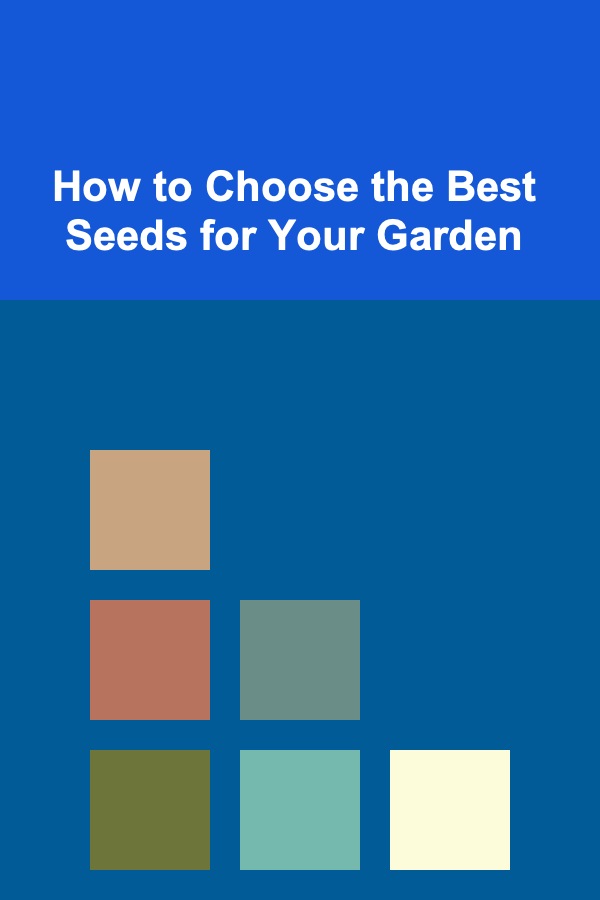
How to Choose the Best Seeds for Your Garden
ebook include PDF & Audio bundle (Micro Guide)
$12.99$8.99
Limited Time Offer! Order within the next:

When it comes to starting a garden, choosing the right seeds is one of the most crucial steps. Whether you're a seasoned gardener or a beginner, selecting the best seeds can significantly affect the growth, yield, and overall health of your plants. With so many varieties, cultivars, and suppliers available, it can be overwhelming to make the right choice. However, understanding your garden's unique needs, climate, and the plants you want to grow will help you make an informed decision.
This guide will walk you through the essential factors to consider when choosing seeds for your garden, from understanding plant types and varieties to knowing where to buy and how to store your seeds properly.
Understanding Your Gardening Environment
Before diving into selecting seeds, it's important to assess your gardening environment. Each plant has specific requirements in terms of soil type, sunlight, temperature, and humidity. Understanding these factors will help you determine which seeds are best suited for your garden.
1. Climate Zone
The climate zone you live in is one of the most important considerations when selecting seeds. Plants have specific temperature ranges that they thrive in, so understanding your local climate zone is key. The United States Department of Agriculture (USDA) Plant Hardiness Zone Map is a widely used resource that divides the country into different zones based on average minimum temperatures.
You can check which zone you live in and choose seeds that are suitable for that zone. For instance:
- Cool-season crops like lettuce, spinach, and peas are best suited for cooler climates and can be planted in early spring or late fall.
- Warm-season crops such as tomatoes, peppers, and beans need a warmer environment and should be planted after the last frost date.
2. Sunlight Requirements
Different plants have varying sunlight needs. Some plants, such as tomatoes and peppers, need full sun (6--8 hours of direct sunlight per day), while others, like leafy greens and root vegetables, can tolerate partial shade.
Before selecting seeds, assess how much sunlight your garden gets. If you have a sunny area, you can choose sun-loving plants, but if your garden is more shaded, opt for plants that thrive in lower light conditions.
3. Soil Type and Quality
The quality and composition of your soil play a significant role in plant growth. Some plants thrive in rich, loamy soil, while others prefer sandy or clay-heavy soil. You can test your soil to determine its pH and nutrient levels. A soil test kit can help you understand if your soil is acidic, neutral, or alkaline, and whether it needs amendments like compost, lime, or fertilizer.
When selecting seeds, it's important to consider the type of soil that each plant prefers. For instance:
- Root vegetables like carrots and radishes prefer well-drained, loose soil.
- Leafy greens such as lettuce and spinach do well in fertile, slightly acidic soil.
4. Garden Space
How much space do you have available for your garden? If you have a small balcony or a limited garden area, you'll need to select compact or dwarf varieties that can thrive in confined spaces. On the other hand, if you have a large garden plot, you may have more flexibility to grow a variety of plants that require more space to spread out.
Consider vertical gardening, container gardening, or raised beds if you're limited on space but still want to grow a variety of plants.
Types of Seeds to Consider
When selecting seeds, you'll find a variety of options based on plant type, growing season, and intended use. Here are some of the most common categories:
1. Heirloom Seeds
Heirloom seeds are open-pollinated varieties that have been passed down through generations. They are often prized for their flavor, diversity, and adaptability. These seeds are a great choice for gardeners looking to preserve traditional plant varieties and biodiversity. They also allow you to save seeds from your own harvest for future planting.
However, heirloom seeds can be more susceptible to disease and pests compared to hybrid varieties, so they may require more care and attention in the garden.
2. Hybrid Seeds
Hybrid seeds are produced by cross-pollinating two different parent plants to achieve a specific trait, such as increased disease resistance or higher yields. While hybrid seeds often produce more uniform plants with desirable characteristics, they can be more expensive and may not be suitable for saving seeds from one year to the next. Many hybrid plants are bred to be more resistant to pests and environmental stresses, making them a good choice for beginners.
3. Organic Seeds
Organic seeds come from plants that have been grown without synthetic pesticides, fertilizers, or genetically modified organisms (GMOs). Organic gardening focuses on sustainability and environmental health, and choosing organic seeds ensures that you're supporting these principles. Organic seeds are widely available for a variety of plants, including vegetables, fruits, and herbs.
4. GMO Seeds
Genetically modified organisms (GMO) seeds have been altered at the genetic level to possess traits that would not occur naturally, such as pest resistance or drought tolerance. While GMO seeds are more commonly used in commercial farming, they are not typically sold to home gardeners. It's important to note that some regions have restrictions on the use of GMO seeds, and their use in home gardening is generally discouraged by organic gardeners.
5. Native Seeds
Native plants are those that occur naturally in a particular region. Choosing native seeds for your garden can help support local wildlife, including pollinators like bees and butterflies. Native plants are also well adapted to the local climate and soil, which can reduce the need for fertilizers and pesticides.
Evaluating Seed Quality
The quality of seeds is a key factor in ensuring healthy and productive plants. Here are some tips on how to evaluate seed quality:
1. Freshness
Seeds lose viability over time, so it's important to select fresh seeds for your garden. Check the expiration date on the seed packet, and avoid buying seeds that are several years old. For long-term storage, seeds should be kept in cool, dry, and dark conditions.
2. Packaging
High-quality seed suppliers often invest in proper packaging to protect seeds from moisture, light, and pests. Look for seed packets that are well-sealed and made of durable materials. Seed packaging should also include information such as the plant's growing requirements, planting depth, spacing, and care instructions.
3. Certified Suppliers
Buying from reputable and certified seed suppliers ensures that you're getting high-quality seeds. Look for suppliers that are members of organizations like the Organic Seed Alliance or the Seed Savers Exchange, which adhere to strict quality standards.
4. Test Germination Rates
Most seed packets will indicate the germination rate, which is the percentage of seeds that are likely to sprout. A high germination rate indicates that the seeds are fresh and viable. If the germination rate is low, you may need to plant more seeds or choose a different variety.
Practical Considerations When Choosing Seeds
1. Growing Season Length
Consider the length of your growing season when selecting seeds. If you live in a short-season climate, choose plants that mature quickly, such as early-season vegetables or dwarf varieties. You can also opt for crops that can be harvested multiple times, like lettuce or spinach, which provide continuous yields throughout the season.
2. Pest and Disease Resistance
If you've struggled with pests or diseases in the past, consider selecting seeds from varieties that are resistant to common garden problems. Many hybrid seeds are bred for resistance to pests, diseases, and environmental stressors. Look for terms like "disease-resistant" or "pest-resistant" on seed packets.
3. Companion Planting
Companion planting is a gardening strategy where certain plants are grown together to benefit one another. For example, planting basil near tomatoes can help repel pests and improve flavor. When choosing seeds, consider the compatibility of plants and how they will interact in your garden. Some plants work well together, while others may compete for space, water, or nutrients.
Where to Buy Seeds
Now that you know what to look for, where should you buy your seeds? There are various places to purchase seeds, including:
- Local nurseries and garden centers: These stores often carry a selection of seeds that are well-suited to your local climate.
- Online seed suppliers: Many online retailers offer a wide variety of seeds, including rare and heirloom varieties. However, it's important to check reviews and ensure the supplier is reputable.
- Farmers' markets: Local farmers' markets often feature seeds from local growers, providing an opportunity to purchase region-specific varieties.
Storing Your Seeds
Proper seed storage ensures that your seeds remain viable for the following growing season. Seeds should be stored in a cool, dry, and dark place. A temperature between 32°F (0°C) and 50°F (10°C) is ideal. You can use airtight containers, such as glass jars or Mylar bags, to keep moisture and pests out.
Label your seed packets with the variety name and expiration date, so you can keep track of what you have and when it should be used.
Conclusion
Choosing the best seeds for your garden requires careful consideration of your local environment, the plants you want to grow, and the specific needs of each plant. By understanding climate zones, soil conditions, and sunlight requirements, you can select seeds that are best suited for your garden. Additionally, paying attention to seed quality, plant variety, and reliable sources will ensure a successful growing season.
With the right seeds and the proper care, your garden will flourish and provide you with a bountiful harvest. Happy gardening!

How to Make the Most of Your Small Balcony
Read More
How to Use Community Resources for Home Security
Read More
How To Find TV Shows That Focus on Friendship
Read More
How to Incorporate More Fiber into Your Diet
Read More
How to Design a Scalable Database Architecture
Read More
How to Create a Blog Planner for Seasonal Content
Read MoreOther Products

How to Make the Most of Your Small Balcony
Read More
How to Use Community Resources for Home Security
Read More
How To Find TV Shows That Focus on Friendship
Read More
How to Incorporate More Fiber into Your Diet
Read More
How to Design a Scalable Database Architecture
Read More